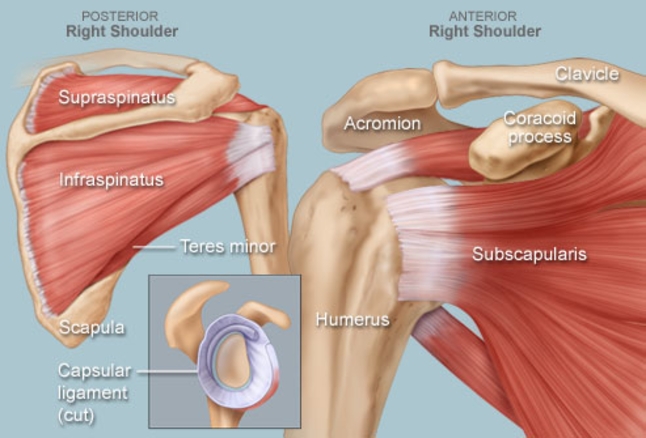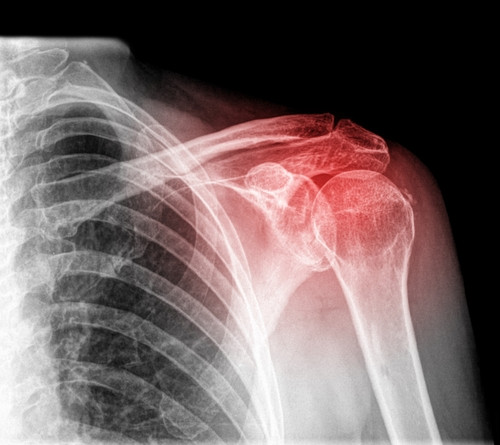Have you ever had a problem with your shoulder? This article is aiming at proving more information about what you might be wrong with your shoulder.
The shoulder is one of the largest and most complex joints in the body. This joint is formed where the humerus (upper arm bone) fits into the scapula (shoulder blade), like a ball and socket. Other important bones in the shoulder include:
- The acromion is a bony projection off the scapula.
- The clavicle (collarbone) meets the acromion in the acromioclavicular(AC) joint.
- The coracoid process is a hook-like bony projection from the scapula.
The shoulder has several other important structures(see picture):
- The rotator cuff is a collection of muscles and tendons that surround the shoulder, giving it support and allowing a wide range of motion.
- The bursa is a small sac of fluid that cushions and protects the tendons of the rotator cuff.
- A cuff of cartilage called the labrum forms a cup for the ball-like head of the humerus to fit into.
The humerus fits relatively loosely into the shoulder joint. This gives the shoulder a wide range of motion but also makes it vulnerable to injury.

Image source: WebMD Image Collection: Human Anatomy
The rotator cuff is a group of tendons and muscles in the shoulder, connecting the upper arm (humerus) to the shoulder blade (scapula). The rotator cuff tendons provide stability to the shoulder; the muscles allow the shoulder to rotate. The muscles in the rotator cuff include Teres minor, Infraspinatus, Supraspinatus and Subscapularis.
Each muscle of the rotator cuff inserts at the scapula and has a tendon that attaches to the humerus. Together, the tendons and other tissues form a cuff around the humerus.
Shoulder pain
Shoulder pain is an extremely common issue, and there are many common causes of this problem. It is important to make an accurate diagnosis of the cause of your symptoms so that appropriate treatment can be directed at the cause. If you have shoulder pain, some common causes include:
- Frozen shoulder: Inflammation develops in the shoulder that causes pain and stiffness. As a frozen shoulder progresses, movement in the shoulder can be severely limited.
- Osteoarthritis: The common “wear-and-tear” arthritis that occurs with ageing. The shoulder is less often affected by osteoarthritis than the knee.
- Rheumatoid arthritis: A form of arthritis in which the immune system attacks the joints, causing inflammation and pain. Rheumatoid arthritis can affect any joint, including the shoulder.
- Gout: A form of arthritis in which crystals form in the joints, causing inflammation and pain. The shoulder is an uncommon location for gout.
- Shoulder dislocation: The humerus or one of the other bones in the shoulder slips out of position. Raising the arm causes pain and a “popping” sensation if the shoulder is dislocated.
- Shoulder impingement: The acromion (edge of the scapula) presses on the rotator cuff as the arm is lifted. If inflammation or an injury in the rotator cuff is present, this impingement causes pain.
- Shoulder tendonitis: Inflammation of one of the tendons in the shoulder’s rotator cuff.
- Shoulder bursitis: Inflammation of the bursa, the small sac of fluid that rests over the rotator cuff tendons. Either pain with overhead activities or pressure on the upper outer arm are both symptoms.
- Labral tear: An accident or overuse can cause a tear in the labrum, the cuff of cartilage that overlies the head of the humerus. Most labral tears heal without requiring surgery.
- Rotator cuff injury: general term to describe inflammation (soreness and swelling) or damage to one or more of the muscles, tendons or bursa that make up the rotator cuff.
ROTATOR CUFF INJURIES
There are three common conditions that can affect the rotator cuff: rotator cuff tendonitis, rotator cuff impingement syndrome and a rotator cuff tear. Most people with rotator cuff problems can be successfully treated by a combination of rest, painkillers, anti-inflammatories, and physiotherapy and steroid injections. Surgery is sometimes an option
Rotator cuff tendinopathy
Rotator cuff tendonitis is caused by irritation and inflammation of the tendons of the rotator cuff muscles. It tends to have an acute (sudden) onset. There is often a specific preceding injury.
It can happen because of the recent overuse of the shoulder. For example, it can occur in athletes, particularly those who participate in throwing sports. In non-athletes, there may be a history of recent heavy lifting or activities involving repetitive movements of the shoulder.
Sometimes the rotator cuff tendons can become calcified. This is when calcium is deposited in the tendons, due to long-standing inflammation. This is called calcific tendonitis. The tendons of the rotator cuff can become pinched against one of the other structures that make up the shoulder joint. This can cause the tendons to become inflamed and is known as tendinopathy.
Rotator cuff tendinopathy most often affects the tendons that pass through subacromial space. When a tendon becomes trapped or squeezed, it’s known as rotator cuff impingement.
Rotator cuff tear
This is when one or more of muscles and tendons that make up your rotator cuff tear: partial or a full-thickness tear. It may be as a result of trauma, such as a fall, or because of tiny tears in the tendon caused by use and wear over time. A rotator cuff tear is a common cause of pain and disability among adults. A torn rotator cuff will weaken your shoulder. This means that many daily activities, like combing your hair or getting dressed, may become painful and difficult to do. The most common symptoms of a rotator cuff tear include:
- Pain at rest and at night, particularly if lying on the affected shoulder
- Pain when lifting and lowering your arm or with specific movements
- Weakness when lifting or rotating the arm
- Crepitus or crackling sensation when moving the shoulder in certain positions
What causes rotator cuff tears?
Rotator cuff injuries may occur for a specific reason. Some examples are listed below.
- Lifting or pulling an object that is too heavy for you, with a jerking motion.
- Landing on an outstretched hand to break a fall.
- Repeating the same shoulder movements, for example, throwing or lifting.
- A lack of blood supply, caused by getting older, can lead to a tendon tear because it slows down your body’s ability to repair the damage.
- As people get older, growths of bone (bone spurs) may develop on the underside of the acromion and rub on rotator cuff tendons.
People over 40 have an increased risk because most of rotator cuff injuries are caused by normal wear and tear that happens as they age. There are some things that increase the likelihood of you getting a rotator cuff injury, including the following: repetitive overhead motions with the arms without compensation exercises. Examples include swimming, weightlifting, playing racquet sports and occupations such as painting, decorating or window cleaning.
How rotator cuff tears affect your life
Tears in your rotator cuff are not life-threatening, but they can limit movement and cause pain. Limited movement: even small shoulder and arm movements, like combing your hair, putting on a coat, or lifting groceries, may be difficult and can hurt.
Pain: can range from mild to moderate, to sharp. You may feel pain on top of and in front of your injured shoulder. The pain may spread down the outside of your upper arm. You may feel more pain at night, especially when you are lying on the injured shoulder.
Swelling: swelling from inflammation is your body’s natural response to injury. Sometimes this swelling is inside of your body and you cannot see it. This swelling is the most common cause of your pain.
Cracking and stiffness: you may hear a clicking, cracking, or popping sounds when you move your shoulder, especially when lifting something heavy.
Your doctor will ask about your symptoms and examine you. He or she may ask about your medical history and any activities that may be causing your condition. You may be referred for further tests so that your doctor can look at your shoulder in more detail. This may include one or more of the following tests:
- MRI scan – magnets and radio waves to produce images of the inside of your body. Read more here.
- Ultrasound scan – sound waves to produce an image of the inside of your shoulder.
- X-ray – uses radiation to produce an image of the inside of your body.
Treatment of rotator cuff injuries
Treatment of a rotator cuff injury depends on the type of injury you have and how severe it is.
- Rest your shoulder initially. Limit activities that involve lifting your arm over your head and don’t perform any movements that cause you pain. Start to do gentle movements as soon as possible to prevent any stiffness in your shoulder.
- If you need pain relief you can take over-the-counter painkillers, such as paracetamol, or non-steroidal anti-inflammatory drugs, (NSAIDs) such as ibuprofen. Always read the patient information leaflet that comes with your medicine and if you have any questions, ask your pharmacist for advice.
Physiotherapy
A physiotherapist (or another health professional that specialises in maintaining and improving movement and mobility) can show you suitable exercises to help stretch your shoulder muscles and improve the strength and movement of your shoulder. The exercises will be tailored to your specific injury. If you have a rotator cuff tear that isn’t getting better after trying other types of treatment, your doctor may recommend that you have a Cortisone (Corticosteroid) injection, into your shoulder joint.
Surgery
Your doctor may recommend surgery if you have torn your rotator cuff and if other types of treatment haven’t worked for you. There are several types of surgery that may be used to repair a rotator cuff injury.
- Open surgery – a traditional type of surgery that means your surgeon makes a cut in the skin over your shoulder and repairs your injury through the cut.
- Shoulder arthroscopy – a type of keyhole surgery that can be used to look inside and treat your shoulder joint. This is usually done under local anaesthesia. This completely blocks pain from your shoulder area and you will stay awake during the operation.
- Mini-open surgery – a combination of arthroscopy and repair through a small cut that is usually 3 to 5cm long.
Please consult with your doctor or health care professional before deciding to take any action regarding your shoulder recovery after an injury.
References
www.nlm.nih.gov
www.bupa.co.uk
www.patient.co.uk
http://effectivehealthcare.ahrq.gov
http://orthoinfo.aaos.org


Thanks for posting this awesome article. I’m a long time reader but I’ve never
been compelled to leave a comment. I subscribed to your blog and shared this on my Facebook.
Thanks again for a great post!
Thanks for your marvellous posting! I seriously enjoyed reading it, you might be a great author.
I will make sure to bookmark your blog and will come back from now on. I want to encourage one to continue your
great work, have a nice weekend!